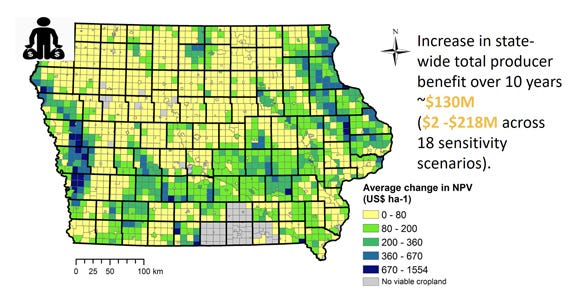November 21, 2019

Switchgrass is a hardy perennial crop that could become a third profitable cash crop for Iowa’s farmers in the right fields and with a number of supportive marketplace developments. So, the answer to “Should Iowa farmers switch to grass?” is “Maybe.”
In an Iowa Learning Farms webinar recorded in September, Emily Heaton, an Iowa State University associate professor and Extension biomass expert, discussed findings on profitable alternative crops from multiyear studies integrating perennials into annual agriculture systems to improve diversity, water quality and profitability. The full webinar is available here.
In last month’s column, we covered the challenges of managing erosion and nutrient loss facing Iowa’s farmers. This month, we explore her arguments for establishing a third cash crop that may flip money-losing sections of farms to profit centers in coming years.
Areas of farm fields that aren’t well-suited to corn and beans are often good sites for perennial plantings. Switchgrass is one perennial that is native to Iowa and will thrive throughout Iowa’s climate swings, while providing year-round ground coverage that reduces erosion and nutrient loss. The primary uses for switchgrass are forage, energy production, and fiber or pulp-based products.
Would it be a profitable?
According to the U.S. Department of Energy, switchgrass can produce more energy per acre than corn. But unfortunately, most traditional analyses show switchgrass would not be a profitable crop in Iowa.
In discussing the viability of switchgrass as a cash crop, Heaton says, “When we looked at other studies, we found the profitability estimates were based on county-level data granularity. This cannot identify areas within fields that are not profitable for growing corn and beans but are viable sites for switchgrass.”
The study spanned four years and used publicly available data, including weather records, soil maps, visual satellite imagery, published input costs, yields and grain market prices. The analysis resulted in detailed field-level maps, which offer farmers new information to base crop decisions.
The researchers established two performance thresholds for both crop profitability and nitrogen leaching. The more conservative thresholds identified areas that consistently lost more than $100 per hectare and leached more than 50 kilograms of nitrogen per hectare per year.
Taking a more aggressive approach to nitrate reduction, the second set of thresholds incorporated areas that merely broke even economically and still leached more than 20 kg of nitrogen per hectare per year.
Competing with cash crops
When analyzed together, the data yielded well-defined areas within fields that were consistently underproducing and affecting the overall economic performance of farming enterprises. Essentially, farmers could save money by not planting corn and soybeans in these areas, and reduce nitrogen leaching and erosion by planting perennial switchgrass. It’s a step in the right direction for the environment and the balance sheet, but not necessarily an incentive to consider switchgrass as a cash crop.
Based on the analysis, about 12% of Iowa cropland is losing more than $100 per hectare and leaching nitrogen at rates of more than 50 kg per hectare per year. Just converting these areas to switchgrass could reduce statewide nitrogen leaching by more than 18% and increase overall farm profitability.

PRODUCER BENEFIT: An ISU study looked at where the net present value (NPV) would be greatest for producing switchgrass over a 10-year period in Iowa.

Having determined where switchgrass might stem losses, the decision to take it on as a cash crop is still rooted in factors outside the control of a farmer. As with any new product or innovation, the marketplace for switchgrass must mature. DOE estimates a market price of $55 per ton for switchgrass. At this price, much of Iowa’s farm fields could be profitable, and in some areas, substantially more profitable than corn and beans.
Processing capacity needed
However, the capacity to process switchgrass into energy or pulp products needs to expand along with farm production. The production and consumption sides of this nascent market must grow logically to maximize its potential. “Iowa doesn’t have a large pulping industry, but industries like egg production have substantial demands for fiber-based products such as egg cartons,” Heaton says. “Imagine if the largest egg-producing state could also produce the needed packaging for the entire industry.”
Heaton and other researchers are continuing to work on improving analysis and modeling tools to give farmers more insight into which crops will deliver the most financial benefit. There is growing evidence that planting switchgrass can improve profitability. Also, there is some indication it could be a viable cash crop in Iowa. For farmers ready to jump onboard, switching to grass may be an interesting and profitable venture.
Pierce is an ISU Extension program specialist focusing on water quality with Iowa Learning Farms.
You May Also Like




